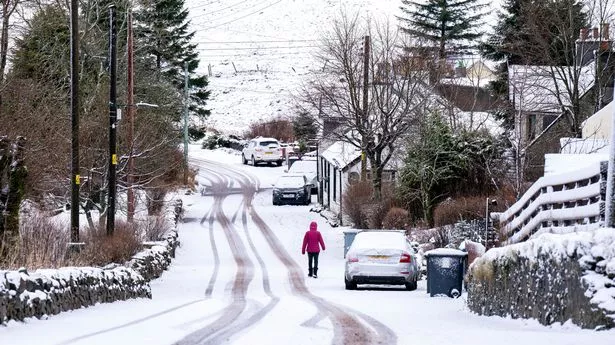Terrifying new weather maps show the exact time a huge 874-mile-long snow wall will batter the UK.
According to the graphics from WXCharts a huge mass of snow will blanket much of the country, with only a few exceptions. The snowfall could even stack up to as much as 24cm in some places. The chilly conditions would stand in stark contrast to the more milder spell the country has experienced in the run-up to Christmas where temperatures tipped into the double digits in some areas.
But should the WXCharts map prove to be correct, there will be few areas that will escape the incoming snowfall. Maps for 12pm on January 2 forecast snow will fall heaviest in northern Scotland where it could reach a minimum of just over 20cm and a maximum of 24cm in the Highlands with similar amounts falling along the east coast.
The maps also show totals of between 4cm and 6cm in a large stretch from the Scottish borders all the way down to Yorkshire. In the south, the amount of falling snow will lessen further into the day with both southern England and Wales seeing less of the white stuff compared to other regions. The WXCharts maps show that there will be some areas that will largely be untouched.
They show that the west and central Midlands, especially around Birmingham are unlikely to see any snow at all. While WXCharts has forecast snow, the Met Office is still reserving judgement on whether Brits will see the white stuff or snow.
In its long-range weather forecast for December 30 to January 8, the Met Office said: "Fronts or low-pressure areas are increasingly likely to move south/east across much of the country, bringing an increased threat of heavy rain and perhaps strong winds.
"As colder air from the north progresses southwards, the risk of sleet and snow increases, especially in northern areas, but this will depend each day on where the thermal boundary lies. Temperatures will start around average but will become a little below average for most, especially in the north, though milder interludes are still possible in the south. While there is moderate to high confidence in this trend, confidence is low for the exact positioning of any systems, which will be crucial in determining which areas see rain or snow."
The Met Office's long range weather forecast for December 30 to January 8 reads: "Fronts or low-pressure areas are increasingly likely to move south/east across much of the country, bringing an increased threat of heavy rain and perhaps strong winds. As colder air from the north progresses southwards, the risk of sleet and snow increases, especially in northern areas, but this will depend each day on where the thermal boundary lies.
"Temperatures will start around average but will become a little below average for most, especially in the north, though milder interludes are still possible in the south. While there is moderate to high confidence in this trend, confidence is low for the exact positioning of any systems, which will be crucial in determining which areas see rain or snow."
